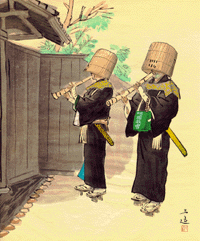
Tone Takahashi
TOZAN
RYU:
An Innovation of the Shakuhachi Tradition
from Fuke-shu to Secularism
 |
Tone Takahashi TOZAN
RYU: |
The first part of this study investigates the history of the Fuke sect and the development of the shakuhachi from its origins to the abolition and revival of the sect; the remaining chapters deal with the Tozan-ryu. Translations of all the different extant versions of the Keicho No Okitegaki, a statute which regulated the special privileges accorded to the komuso (mendicant priests) by the Tokugawa authorities, are given and discussed. To the author's knowledge, these documents have not yet been translated into English.
Pertinent data have been collected that sustain the hypothesis the Tozan-ryu is the result of a transformation of style due to new artistic and economic changes as well as cultural shifts that developed in Japan shortly after World War II. The discussion also presents a comparative study of the Fuke tradition and the Tozan-ryu.
Although the Tozan-ryu developed out of a strong socio-religious heritage, it was also based on a new concept prevailing in early twentieth-century Japan. The combination of an artistic process of secularism, a Western educational influence and a new economic stimulus were the three major factors in this transformation.
The treatment of miyako-bushi (the in [dark] mode), the basic scale of Japanese secular music, is examined in the context of Nakao Tozan's early work.
367 pages. 8 1/2" x 11" Photocopy. Unbound format. BK-10
|
Riley Lee, YEARNING FOR THE BELL: A Study of Transmission in the Shakuhachi Honkyoku Tradition Andreas B. Gutzwiller SHAKUHACHI: Aspects of History, Practice & Teaching |
| Price of Book | Ordering Information |